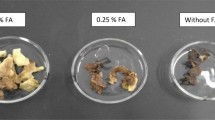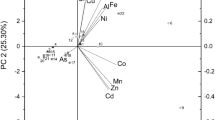Abstract
Twenty species of seaweed were collected from the coast of Zhejiang, China, extracted with ethanol, and screened for algicidal activity against red tide microalgae Heterosigma akashiwo and Prorocentrum micans. Inhibitory effects of fresh and dried tißsues of green alga Ulva intestinalis were assessed and the main algicidal compounds were isolated, purified, and identified. Five seaweed species, U. intestinalis, U. fasciata, Grateloupia romosissima, Chondria crassicaulis, and Gracilariopsis lemaneiformis, were investigated for their algicidal activities. Fresh tissues of 8.0 and 16.0 mg/mL of U. intestinalis dissolved in media significantly inhibited growth of H. akashiwo and P. micans, respectively. Dried tissue and ethyl acetate (EtOAc) extracts of U. intestinalis at greater than 1.2 and 0.04 mg/mL, respectively, were fatal to H. akashiwo, while its water and EtOAc extracts in excess of 0.96 and 0.32 mg/mL, respectively, were lethal to P. micans. Three algicidal compounds in the EtOAc extracts were identified as 15-ethoxy-(6z,9z,12z)-hexadecatrienoic acid (I), (6E,9E,12E)-(2-acetoxy-β-D-glucose)-octadecatrienoic acid ester (II) and hexadecanoic acid (III). Of these, compound II displayed the most potent algicidal activity with IC50 values of 4.9 and 14.1 µg/mL for H. akashiwo and P. micans, respectively. Compound I showed moderate algicidal activity with IC50 values of 13.4 and 24.7 µg/mL for H. akashiwo and P. micans, respectively. These findings suggested that certain macroalgae or products therefrom could be used as effective biological control agents against red tide algae.
Similar content being viewed by others
References
Alamsjah M A, Hirao S, Ishibashi F, Fujita Y. 2005. Isolation and structure determination of algicidal compounds from Ulva fasciata. Biosci. Biotech. Bioch., 69 (11): 2 186–2 192.
Alamsjah M A, Hirao S, Ishibashi F, Oda T, Fujita Y. 2008. Algicidal activity of polyunsaturated fatty acids derived from Ulva fasciata and U. pertusa (Ulvaceae, Chlorophyta) on phytoplankton. J. Appl. Phycol., 20 ((5): 713–720.
Baeck S, Lehvo A, Blomster J. 2000. Mass occurrence of unattached Enteromorpha intestinalis on the Finnish Baltic Sea coast. Ann. Bot. Fenn., 37 ((3): 155–161.
Cross E M. 2003. Allelopathy of aquatic autotrophs. Crit. Rev. Plant Sci., 22 (3-4): 313–339.
Guillard R R L, Rytger J H. 1962. Studies of marine planktonic diatoms. I. Cyclotella nana Hustedt and Detonula confervaceae (cleve) Gran. Can. J. Microbiol., 8: 229–239.
Hong Y, Hu H Y. 2009. Research and application of inhibitory allelopathy from aquatic plants on algae. Chinese Sci. Bull., 54 ((3): 287–193.
Jeong J H, Jin H J, Sohn C H, Suh K H, Hong Y K. 2000. Algicidal activity of the seaweed Corallina pilulifera against red tide microalgae. J. Appl. Phycol., 12 ((1): 37–43.
Jin Q, Dong S L, Wang C Y. 2005. Allelopathic growth inhibitory of Prorocentrum micans (Dinophyta) by Ulva pertusa and Ulva linza (Chlorophyta) in laboratory cultures. European J. Phycol., 40 ((1): 31–37.
Jin Q, Dong S L. 2003. Comparative studies on the allelopathic effects of two different strains of Ulva pertusa on Heterosigma akashiwo and Alexandium tamarense. J. Exp. Mar. Biol. Ecol., 293 ((1): 41–55.
Kim J H, Kang E J, Park M G, Lee B G, Kim K Y. 2010. Effects of temperature and irradiance on photosynthesis and growth of a green-tide-forming species (Ulva linza) in the Yellow Sea. J. Appl. Phycol., 23 ((3): 421–432.
Laabir M, Grignon-Dubois M, Masseret E, Rezzonico B, Soteras G, Rouquette M, Rieuvilleneuve F, Cecchi P. 2013. Algicidal effects of Zostera marina L. and Zostera noltii Hornem. extracts on the neuro-toxic bloom-forming dinoflagellate Alexandrium catenella. Aquat. Bot., 111: 16–25.
Meng Y, Deng Q, Xu G. 1999. Studies on the chemical constituents of Chinese herb Rabdosia serra (Maxim.) Hara (II). Natural Product Research and Development, 12(3): 27–29.
Nan C R, Zhang H Z, Lin S Z, Zhao G Q, Lin X Y. 2008. Allelopathic effects of Ulva lactuca on selected species of harmful bloom-forming microalgae in laboratory cultures. Aquat. Bot., 89 ((1): 9–15.
Park S C, Lee J K, Kim S W, Park Y. 2011. Selective algicidal action of peptides against harmful algal bloom species. PLoS One, 6 (10): e26733.
Pei H Y, Hu W R, Mu R M, Li X C. 2007. Alga-lysing bioreactor and dominant bacteria strain. Journal of Environmental Sciences, 19 ((5): 546–552.
Tang Y Z, Gobler C J. 2011. The green macroalga, Ulva lactuca, inhibits the growth of seven common harmful algal bloom species via allelopathy. Harmful Algae, 10 ((5): 480–488.
Wang R J, Xiao H, Zhang P Y, Qu L, Cai H J, Tang X X. 2007. Allelopathic effects of Ulva pertusa, Corallina pilulifera and Sargassum thunbergii on the growth of the dinoflagellates Heterosigma akashiwo and Alexandrium tamarense. J. Appl. Phycol., 19 (2): 109–121.
Wang Y, Wang Y, Zhu L, Zhou B, Tang X X. 2012. Comparative studies on the ecophysiological differences of two green tide macroalgae under controlled laboratory conditions. PLoS One, 7 (8): e38245.
Wang Y, Zhou B, Tang X X. 2009. Effects of two species of macroalgae Ulva pertusa and Gracilaria lemaneiformis on growth of Heterosigma akashiwo (Raphidophyceae). J. Appl. Phycol., 21 ((4): 375–385.
Xu N J, Tang J, Zhang Z W, Yan X J. 2009. Inhibitory effects of Spartina anglica on Heterosigma akashiwo and Prorocentrum micans and the isolation and identification of the algicidal compounds. Chinese Journal of Applied Ecology, 20 (10): 2 563–2 568. (in Chinese)
Xu Y, Dong S L, Yu X M. 2005. The allelopathic effects of Enteromorpha linza on Heterosigma akashiwo. Acta Ecol. Sin., 25 (10): 2 681–2 685. (in Chinese)
Yang X R, Su J Q, Zheng T L. 2008. The importance and potential application of allelopathy in red-tide control. Acta Scientiae Circumstantiae, 28 ((2): 219–226. (in Chinese)
Ye N H, Zhuang Z M, Jin X S, Wang Q Y, Zhang X W, Li D M, Wang H X, Mao Y Z, Jiang Z J, Li B, Xue Z X. 2008. China is on the tracking Enteromorpha spp. forming green tide. Nature Proceedings, hdl:10101/npre.2008. 2352.1.
Yu Z M, Sengco M R, Erson D M. 2004. Flocculation and removal of the brown-tide organism, Aureococcus anophagefferens, using clays. J. Appl. Phycol., 16 ((2): 101–110.
Zhou X J, Bai M D, Deng S F, Dong K B, Xing L. 2004. Study on killing Gymnodinium mukimotoi with hydroxyl radical. Marine Environmental Science, 23 ((1): 64–66. (in Chinese)
Author information
Authors and Affiliations
Corresponding author
Additional information
Supported by the National Natural Science Foundation of China (Nos. 40876073, 41276122), the Doctoral Fund of the Ministry of Education (No. 20123305110002), and the K. C. Wong Magna Fund from Ningbo University
Rights and permissions
About this article
Cite this article
Sun, X., Jin, H., Zhang, L. et al. Screening and isolation of the algicidal compounds from marine green alga Ulva intestinalis . Chin. J. Ocean. Limnol. 34, 781–788 (2016). https://doi.org/10.1007/s00343-016-4383-z
Received:
Accepted:
Published:
Issue Date:
DOI: https://doi.org/10.1007/s00343-016-4383-z




